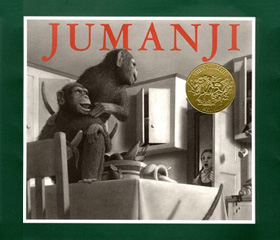
Book Summary:
Two kids are left home with one task: keep the house clean. Immediately they started play with their toys but soon were bored. They found a game under the tree in the park and brought it back home. It was very clear that they should read the instructions which were very short but clear. They started playing and every description they landed on became true. From lions, to rhinos, monkeys tearing up the kitchen, lava erupting out of the fireplace, etc. and they had to finish the game in order for these events and creatures to disappear. Julie, the sister, finished first and everything disappeared. They took the game back to the park, and fell asleep playing a puzzle until their parents came home with their guests. The book ends with the children seeing two other kids running through the park with the box in their hands.
APA Reference of Book:
Van Allsburg, C. (1981). Jumanji. New York, NY: Houghton Mifflin Company.
Impressions:
When I first picked up this book I immediately thought of the movie Jumanji. I watched that movie a long time ago and did not remember most of it, just a few expressions and actors. I was pleasantly surprised by this book, it kept me on edge with the story so I had to read it three times to fully appreciate the story and the illustrations. When I saw the book was pretty wordy I was unsure if children would be interested in the story, but when I started reading it I could see how it would keep them interested. The illustrations were more on the realistic side which I believe fit the story nicely, even though it is very much fantasy where board games make instances real.
Professional Review:
"VAN ALLSBURG, Chris, Jumanji. illus. by author. unpaged. CIP. Houghton. Apr. 1981. PLB $9.95. ISBN 0-395-30448-2. LC 80-29632.
Gr 1-4 --- Jumanji is a jungle adventure board game come to life via the magic that, in Van Allsburg's world, is always waiting to leak into the everyday. With successive dice rolls, deepest darkest Africa invades the neat, solid, formally arranged rooms of the unsuspecting players' house. The players -- a blase brother and sister home alone -- are momentarily dumbstruck but not really upset. They steadfastly go on with the game as monkeys, grinning with a wicked gleam, raid the kitchen and hunker around the game board; rhinos charge intently through the living room (and right into one's line of vision); a Python coils on the mantel, its pattern set off by a leafy slipcover design to give a jungle camouflage effect. As in The Garden of Abdul Gasazi (Houghton, 1979), which Jumaji outdoes in story terms, real and unreal rub shoulders in three-dimensional drawings extraordinary for the multiplicity of gray tones the artist achieves and the startling contrasts with brilliant white. The eye-fooling angles, looking shadows and shifting perspectives are worthy of Hitchcock, yet all these "special effects" are supplied with only a pencil. --Pamela D. Pollack, "School Library Journal" "
Gr 1-4 --- Jumanji is a jungle adventure board game come to life via the magic that, in Van Allsburg's world, is always waiting to leak into the everyday. With successive dice rolls, deepest darkest Africa invades the neat, solid, formally arranged rooms of the unsuspecting players' house. The players -- a blase brother and sister home alone -- are momentarily dumbstruck but not really upset. They steadfastly go on with the game as monkeys, grinning with a wicked gleam, raid the kitchen and hunker around the game board; rhinos charge intently through the living room (and right into one's line of vision); a Python coils on the mantel, its pattern set off by a leafy slipcover design to give a jungle camouflage effect. As in The Garden of Abdul Gasazi (Houghton, 1979), which Jumaji outdoes in story terms, real and unreal rub shoulders in three-dimensional drawings extraordinary for the multiplicity of gray tones the artist achieves and the startling contrasts with brilliant white. The eye-fooling angles, looking shadows and shifting perspectives are worthy of Hitchcock, yet all these "special effects" are supplied with only a pencil. --Pamela D. Pollack, "School Library Journal" "
Pollack, P. D. (1981). [Review of the book Jumanji, by C. Van Allsburg]. School Library Journal, 27(9), 60. Retrieved from http://www.slj.com
Library Use: I think it would be fun to create a board game like Jumanji and with the events we can turn them into fun things for the kids. Maybe just for fun if the lion came in, we could get a lion puppet or stuffed animal out. Just play along those lines.
No comments:
Post a Comment